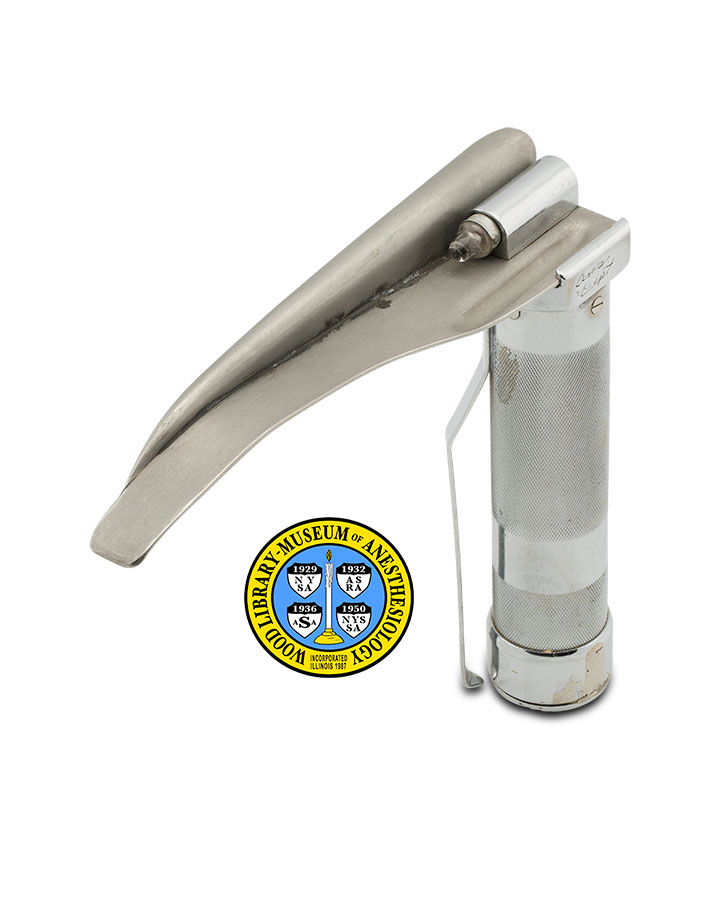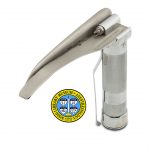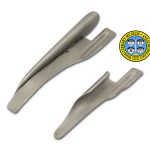Morch Laryngoscope
Anesthesiologist and inventor Ernst Trier Morch, M.D. (1908-1996) was the first physician to specialize in anesthesia in Denmark. He learned to use a McKesson nitrous oxide-oxygen machine in 1940. His teacher was Mr. Ole Lippmann (1916-2002), Director of the Copenhagen medical equipment firm, Simonsen & Weel. Mr. Lippman and Dr. Morch worked together again in the Danish resistance to German occupation during WWII. With the encouragement of Mr. Lippmann and of New York's Foregger Company, Morch developed a new laryngoscope in 1948. He immigrated to the United States the following year, and introduced his laryngoscope in 1951. It appeared in Foregger's catalogs from 1952 through 1960.
Most of Foregger's laryngoscopes have a hook-on blade, which takes some force to attach and remove. The handle of the Morch laryngoscope has two grooves, and the matching blades are shaped to slide quickly in and out. Another of Morch's innovations was to incorporate the battery-operated light in the handle, instead of in the blade. The accompanying photographs show both a Morch modification of the Macintosh blade, size large, and a Morch modification of the Guedel blade, size small.
Catalog Record: Morch Laryngoscope Morch Laryngoscope
Access Key: aqqd
Accession No.: 1996-04-05-1 F
Title: [Morch Guedel-type laryngoscope blade] / [Designed by Ernst Trier Morch].
Author: Mørch, Ernst Trier (1908-1996).
Publisher: New York, NY : Foregger Company, 1952-1960.
Physical Description: 1 laryngoscope blade : metal ; 1.5 x 3 x 13 cm.
Subject: Airway Management – instrumentation.
Subject: Anesthesia, Intratracheal – instrumentation.
Subject: Laryngoscopes – straight blades.
Subject: Laryngoscopes – battery-powered.
Note Type: General
Notes: The first year in the date range is the year that the laryngoscope was introduced, when it was stated to be available from Foregger. The second year in the date range is the date of the last Foregger catalog to include the laryngoscope.
Described from the perspective of the user.
Note Type: Citation
Notes: Dansk Militaerhistorie website. http://milhist.dk/slaget/the-bombing-of-the-shellhus/. Accessed September 6, 2017.
Note Type: Citation
Notes: The Foregger Company. Catalog. New York: The Foregger Company, 1935:58-59.
Note Type: Citation
Notes: The Foregger Company. Catalog No. 11. New York: The Foregger Company, 1952:124.
Note Type: Citation
Notes: The Foregger Company. Catalog No. 12. New York: The Foregger Company, 1955:139.
Note Type: Citation
Notes: The Foregger Company. Catalog No. 16. New York: The Foregger Company, 1960:50.
Note Type: Citation
Notes: The Foregger Company. Catalog No. 17. New York: The Foregger Company, 1962.
Note Type: Citation
Notes: Haxholdt BF, Secher O. The twenty-fifth anniversary of the Danish Society of Anaesthesiology. Acta Anaesth Scand. December, 1975;19(5):34-329.
Note Type: Citation
Notes: Macintosh RR. A new laryngoscope. Lancet. 1943;1:205.
Note Type: Citation
Notes: Morch ET. Controlled respiration by means of special automatic machines used in Sweden and Denmark. Anaesthesia. March, 1948;3(1):4-10.
Note Type: Citation
Notes: Morch ET. A new laryngoscope. Anesth Analg. November-December, 1951;30(6):358-359.
Note Type: Citation
Notes: Morch ET, inventor. Laryngoscope. US Patent 2,648,329. August 11, 1953.
Note Type: Citation
Notes: Ole Lippmann [Obituary]. The Scotsman website. http://www.scotsman.com/news/obituaries/ole-lippmann-1-621218. Accessed September 9, 2017.
Note Type: Citation
Notes: Rosenberg H, Axelrod JK. Ernst Trier Morch: inventor, medical pioneer, heroic freedom fighter. Anesth Analg. January, 2000;90(1):218-221.
Note Type: Citation
Notes: Simonsen & Weel A/S website. http://www.microsofttranslator.com/bv.aspx?from=da&to=en&a=http%3A%2F%2Fwww.sw.dk%2F200-%25c3%25a5rs-jubil%25c3%25a6um. Accessed September 9, 2017.
Note Type: Citation
Notes: Stromskag KE, Brock-Utne JG, Eklund J, Holmdahl MH. A history of nordic anesthesia. In: Eger EI, Saidman LJ, Westhorpe RN, eds. The Wondrous Story of Anesthesia. New York, NY: Springer, 2014:417-428.
Note Type: Physical Description
Notes: One laryngoscope blade; The shaft of the blade is relatively flat; The back of the blade has a single flange; This flange has a depression that corresponds to the shape of a Morch laryngoscope handle; The metal on the side of the blade that faces upward when the laryngoscope is in use is shiny; This side is marked “GUEDEL [new line] FOREGGER”; The opposite side of the blade is dull.
Note Type: Reproduction
Notes: Photographed by Mr. Steve Donisch, June 20, 2017.
Note Type: Acquisition
Notes: Gift of Parkland Health and Hospital System, Dallas, Texas.
Note Type: Historical
Notes: Anesthesiologists are responsible for maintaining the patient’s respiration during surgery. They may use a laryngoscope to guide a breathing tube through the patient’s larynx (voice box). Danish anesthesiologist and inventor Ernst Trier Morch, M.D. (1908-1996) was the first physician in Denmark to specialize in anesthesia. He was a staunch advocate for anesthesia education. In pursuit of that additional training, himself, he studied under Dr. Torsten Gordh (1907-2010) in Sweden, and Sir Robert R. Macintosh (1897-1989) in England. Dr. Morch immigrated to the United States in 1949.
Morch described his laryngoscope in 1951. In the same year, he applied to patent his design; the patent was granted in 1953. He stated that his laryngoscope was “a simplified modification of the endoscope designed by Dr. Popper of Johannesburg, South Africa.” (The cataloger was unable to identify Dr. Popper.) Morch added that his design was “developed in 1948 through the encouragement and advice of my old friend Major Ole Lund Lippmann, M.B.E., and Richard Foregger, Ph.D.”
Morch noted that his instrument was sold by both Simonsen & Weel, and The Foregger Company. Simonsen & Weel, a medical equipment firm in Copenhagen, was founded in 1817 and continues in business today. Mr. Lippmann (1916-2002) was Director of the company. In 1937, he had visited the U. S. and learned to use a McKesson Nargraf anesthesia machine. In 1939, as the only person in Denmark with such training, he became the first in that country to deliver anesthesia for thoracic surgery cases. In turn, he taught Dr. Morch in this technique. Both Mr. Lippmann and Dr. Morch were members of the Danish resistance to German occupation during WWII.
Dr. Foregger was the founder of The Foregger Company, in New York. The Morch laryngoscope appears in Foregger Co. catalogs for the first time in catalog No. 11, published in 1952. In catalog No. 12, published in 1955, the company added a third blade design to the Morch laryngoscope family. Also in that catalog, the design of the handle has been modified by the addition of the angled vertical bar that is present on the cataloged object. This design continued unchanged in subsequent Foregger catalogs through No. 16, published in 1960. The Morch laryngoscope did not appear in catalog No. 17, published in 1962; the latter is believed to have been the last of Foregger’s full catalogs.
Morch’s design was a departure from the hook-on style common to most of the laryngoscopes made by Foregger. The latter could hold the blade securely in either of two positions: at a right angle to the handle, or folded down against the handle. As Morch described it, his blades “slide in and can be pulled out like a drawer between two small grooves on the handle.” Morch originally designed only two blades of this type; one was his modification of the Guedel blade and the other his modification of the Macintosh blade. By 1955, Foregger had added a third, the Wis-Foregger blade. The original Wis-Foregger was a proprietary version of the Wisconsin blade that had been introduced in 1941 by Dr. Noel A. Gillespie (1904-1955). Each of these was available in three sizes, small, medium and large. Another unusual feature of Morch’s laryngoscope was the placement of the battery-operated light. In most laryngoscopes, then as now, the light was integrated into the blade. But in Morch’s design, it was integrated into the handle. Morch stated this change made it easier to sterilize the blade.
The cataloged object is a small Morch Guedel-type blade. Arthur E. Guedel, M.D. (1883-1956) introduced his laryngoscope around 1935, and it continued to be produced into the 1970s.
Note Type: Exhibition
Notes: Selected for the WLM website



